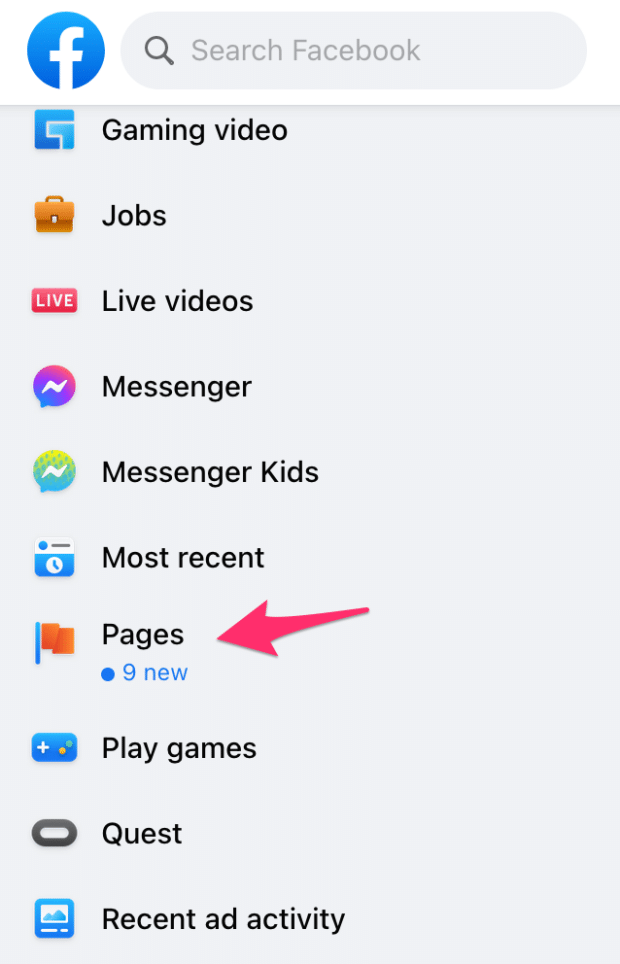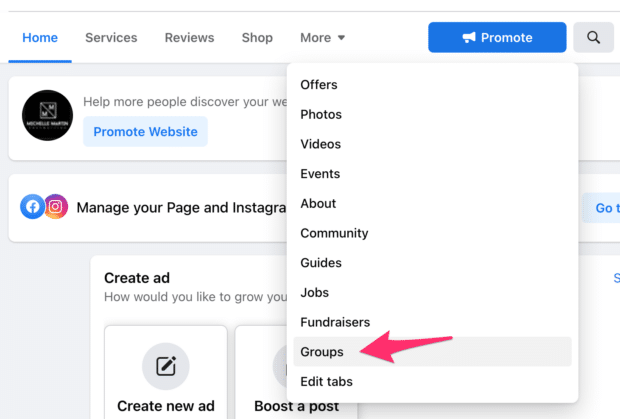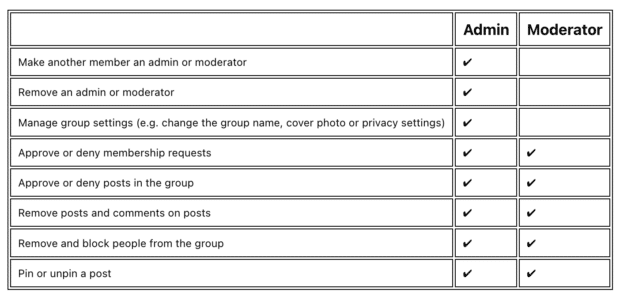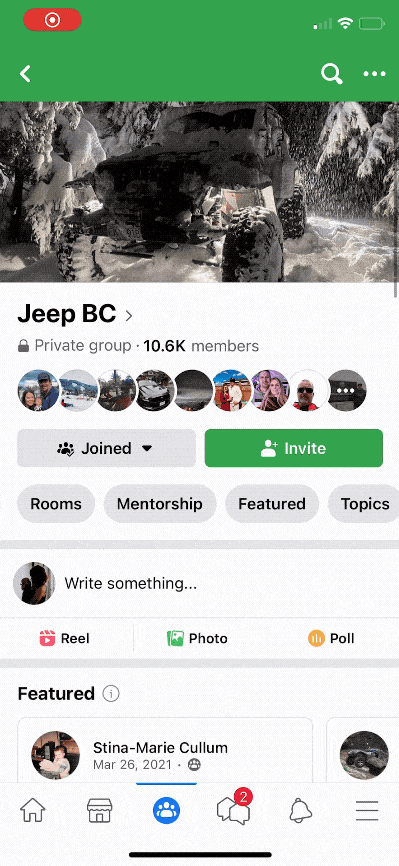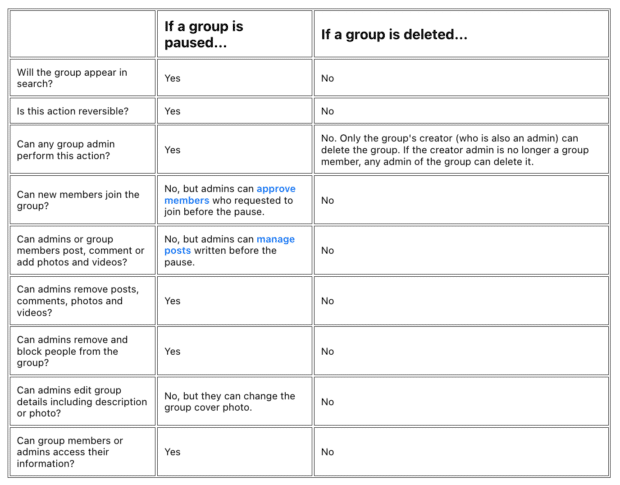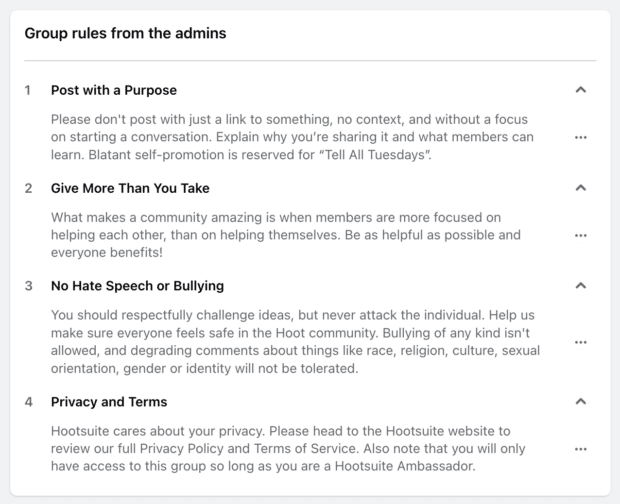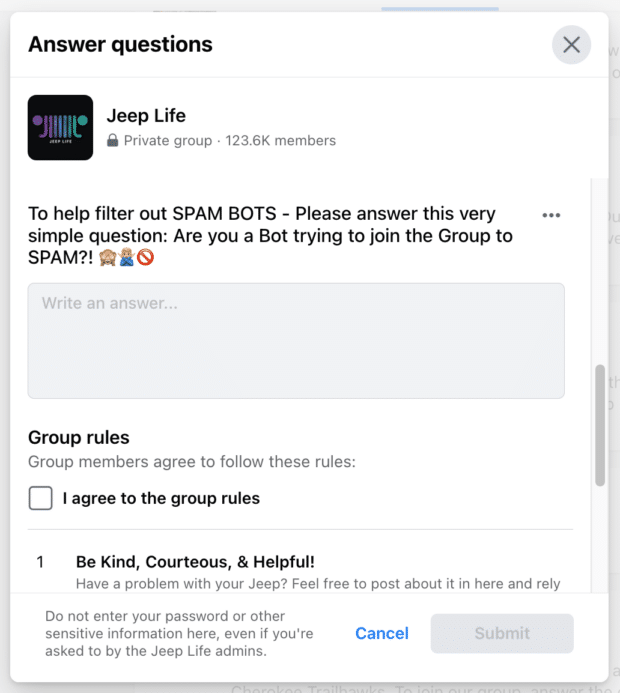How to Use Facebook Groups to Grow Your Business and Engage Customers
Sometimes secrecy is the best way to market your business. I’m talking about Facebook Groups, a.k.a. the VIP way to gain valuable insights from and engage with your top customers.
The math is simple. On the one hand, you have declining organic Facebook reach. On the other, there’s the 1.8 billion people who say they use Facebook Groups every month. These opt-in communities offer businesses a great way to bypass the merciless Facebook news feed algorithm and connect with audiences where they are actually likely to see and interact with branded posts.
Here’s everything you need to know about what a Facebook Group can do for your business. Keep reading to find out how to start one and grow it into a thriving and profitable community.
Bonus: Start crafting your own Facebook group policy with one of our 3 customizable templates. Save time on admin tasks today by providing your group members with clear instructions.
The benefits of setting up a Facebook Group for your business
Your company Facebook Page has its place, but there are unique benefits to including Groups in your Facebook strategy:
Build long-lasting relationships with customers
Groups are effective because people want to be there. Think about it: Is someone going to opt-in to a group for a company they don’t really like?
It’s your #1 BFFs in these groups, and they’re ready to be your personal cheerleading squad. Solidify and enhance that relationship with the exclusive access to your company that a Facebook Group provides, along with special content or privileges. (More on that later.)
Increase your organic reach
The organic reach of your Facebook Page may only be hovering around 5%, but your group’s reach will be much higher.
Facebook prioritizes posts from groups in a user’s newsfeed, so you have a high chance of showing up, especially compared to your Page posts.
Learn valuable market research data
Outside of an organized marketing study, where else can you have direct access to your target audience and get your questions answered by real customers?
Being able to test new strategies and ideas in this small focus group will give you a lot of information. As a bonus, your super fans will appreciate being “in the know.”
It’s a win-win. Oh, and did I mention it’s free? Anyone from a brand new bootstrapped startup to mega-corporations can benefit from this data.
Types of Facebook Groups (and which one you should pick)
It’s important to think about this ahead of time. You can change your group’s privacy only in a few situations, so make sure you set it up the way you want to keep it.
TL;DR? Here’s a quick summary of public versus private Facebook Groups, but watch out for the hidden or visible setting, too — explained below.
Source: Facebook
Public
Public groups are discoverable in search results for everyone. Importantly, the group’s content is also public, including what members post and comment. Anyone on the internet can also see the full list of group members.
And, those group posts and comments are even indexed by Google.
Users can join your group without approval from an administrator. It’s a very “we don’t lock our front doors around here” kind of vibe.
I would not recommend starting a public group. Since anyone can join, including spammers, you’ll need to pay very close attention and delete any inappropriate or spam content that may negatively impact your brand image. It’s really only a matter of time before that happens, so why expose your brand to that?
If you start a public group, you can change it to a private one later on. That change can only happen once as you can’t go back from private to public.
Make life easier and choose private from the start.
Private
There are two types of private groups: visible and hidden. Let’s go over both.
Private – Visible
Private visible groups only allow members to see posts and comments within the group, as well as the member list. But all Facebook users can find these groups in Facebook search results.
This doesn’t expose any content in your group. Only your group title and description are shown in search results if they match the keywords a user typed into the search bar.
Users can ask to join your group, and you, or another administrator, must approve their request. Only then will they be able to view and post content.
This is the best group type for 99% of businesses. It allows you to control membership and filter out spambots while still being publicly discoverable by your target market.
Private – Hidden
Private hidden groups — also known as “secret groups” — have the same features as the groups above, except they do not show up in any search results.
No one on or off Facebook can see group posts, comments, members or find the group in search results. To see the group and ask to join, users must have a direct URL given to them.
This type of group is useful for a truly VIP, invite-only community where you don’t want a lot of people joining. A common example of this type of group is something that goes along with a paid product or select focus or project group.
If you provide a support group to go along with a paid service or specific product, it makes sense to keep that group secret so that non-purchasers can’t find and sneak into your group. Instead, you would only send the link to join to verified purchasers after a sale.
But overall, I recommend going with a private, visible group for most situations.
Coming soon: Visual content groups
Facebook is reportedly adding a new group type soon that will only allow users to post images, videos or very short text posts. Almost like Instagram in a group?
This probably won’t be the right fit for most businesses, but it could work well for certain fields, such as creative challenge groups or a photography club.
Source: Facebook
How to create a group on Facebook
There are multiple ways to create a Facebook group:
- From your computer
- From your phone in the Facebook app
- From your personal Facebook account
- Recommended: From your company Facebook Page (so that your Page is the group’s administrator, along with all your Page’s administrators)
Having your Page as your group’s administrator is a good idea for two reasons:
- It allows all current Page administrators to also manage the group.
- Customers see the administrator’s name, so it’s best to keep this to your company brand instead of yourself as an individual.
To create your group:
1. Log in from an account with administrator access to your company Facebook Business Page.
2. Look for Pages in the left side menu. You may have to click See more and scroll to find it.
3. Click on the Page you want to create a group with. Then click on Groups in the navigation for your Page. Don’t see it? You may have to enable groups for your Page. Check out how to add tabs and sections to do that.
4. Click on Create Linked Group.
5. Add a name for your group and choose the privacy level. You can also invite people who like your Page to join the group, but it’s optional.
6. Now your group is active! Don’t forget to fill out the About section.
Bonus: Start crafting your own Facebook group policy with one of our 3 customizable templates. Save time on admin tasks today by providing your group members with clear instructions.
Get the templates now!How to add an admin to your Facebook Group
Whoever creates a Facebook Group is automatically an administrator, whether it’s your Facebook Page or your own personal account.
To add another person or Page as a Facebook Group admin, follow these steps:
- From the main Facebook page, click on Groups, then Your Groups.
- Select the group you want to add an admin to, and go to its member list. The person or page you want to add must already be a member of the group. Invite them to join if they haven’t already.
- Click the three dots next to the person or page’s name and then click, Invite to be an admin or Invite to be a moderator.
This process is the same whether you’re adding a person or a Page as an administrator.
Admins can remove other admins, including you, so you may want to choose for others to be moderators instead. Here’s a quick rundown of the powers of each:
Source: Facebook
How to change the name of your Group on Facebook
Administrators can change the group’s name at any time, but you can only do so once every 28 days. Additionally, all group members will receive a Facebook notification of the name change.
Here’s how to change the name of your Facebook Group:
- From the Facebook main page, click on Groups and then Your Groups.
- Click Settings in the left side menu.
- Click the edit button (pencil icon on desktop) next to the name field.
- Enter your new name and click Save.
How to post in a Facebook Group
This is the easy part! Posting in a Facebook group is pretty much the same as posting anywhere else on Facebook. Simply go to the group, type out your post in the post section, and click Post.
How to delete a Facebook Group
If you no longer want to run your Facebook group, you can pause or delete it.
Pausing the group lets you keep all of its content: the group itself, posts and the existing member list. It essentially locks the group so that members cannot post any new content. You can choose to resume your group at any time.
Source: Facebook
To pause your group:
- Go to your group while logged in as an administrator.
- Click the three dots at the bottom of the group’s cover photo.
- Choose Pause group.
- Choose a reason for pausing and click Continue.
- Write an announcement informing your members why the group is on pause and if or when you plan to resume it. You can also schedule it to resume at a set date and time.
It’s a good idea to try pausing your group first if you need a break from it, but if you really want to delete it, follow these steps:
- Go to your group and navigate to the Members tab.
- Before you can delete the group, you must remove every member. This can be tedious as you have to click on each member’s name and manually remove them from the group.
- Once you’ve removed everyone, click on your own name (or Page’s name) and choose Leave group.
- The group will cease to exist.
When you delete a group, it simply disappears and your members don’t receive a notification. Not a great user experience for your most valuable brand fans. Plus, it takes so long to manually remove all the members.
The better option is to pause your group, whether you plan to re-activate it or not.
5 tips for Facebook Group marketing success
Create a clear code of conduct
This is a good idea for any group but especially one that represents your business. You can add up to 10 rules in your group’s settings.
Your Facebook Group rules can include basic things like reminding people to be kind or encouraging discussion, but you can also include specific things, such as asking people not to mention competitors or their products.
By stating your rules up front, you set the tone of the group’s behavior. Rules can encourage the behavior you want to see, as well as dissuade behavior you don’t want, like spamming. Rules also give you something to reference if you have to remove or ban a member.
Source: Facebook
Post welcome messages and announcements
As much as it may be tempting to let people talk amongst themselves, make sure to butt in fairly often. Make new members feel at home with a weekly welcome message. Schedule important announcements ahead of time for product launches or special events for your group members.
Engage with members, but let them lead
It’s your job to keep the group productive, on topic and respectful. But don’t try to control too much. Encourage members to start conversations and feel comfortable enough to speak the truth.
Maybe your latest product launch didn’t wow as much as you thought it would. Instead of policing negative opinions and keeping the group as a positive echo chamber, welcome the feedback. Allow users to share their true opinions of what went wrong, thank them for it and keep the conversation going.
You don’t want your members to go rogue and bash you all the time, but seeking to control people’s speech will only backfire in the long run.
Ask admittance questions to keep out bots
This one is critical to keep spammers out. You can ask up to three questions people have to answer when they join. This allows you to somewhat vet incoming members.
A few common things groups ask for are:
- For users to read and agree to follow the group rules.
- Email addresses (both for marketing and verification purposes).
- An easy to answer but specific question to prove humanity.
Not only will robots be unable to answer your questions intended for carbon-based lifeforms, but this is also useful to restrict access to your group as needed.
For example, if your group is for current customers only, asking for their work email address allows you to check whether they’re a customer or not.
Source: Facebook
Offer high-value, unique content in your group
Why should one of your loyal customers or fans join your group? What special something are they getting out of it? If you can’t answer that, you’ve got a big problem.
Being involved in your group is a higher form of commitment than the average customer would take unless they’re given a good reason to join. These are your most valuable peeps! Give ‘em something good.
A few ideas for Facebook-group-only content:
- A monthly AMA (Ask Me Anything) thread
- Livestreams or other live events
- Special discounts
- Early access to new launches
- Survey invitations in exchange for payment or an exclusive discount
- Voting on new product options (colors, features, etc.)
- The opportunity to become affiliates and earn commissions for making sales on your behalf
There are countless ways to make your group members feel special, but you only need to do one or two to make it happen. Think about what you can offer that’s valuable and scalable to your group.
Stuck on ideas? Don’t worry. Just ask your group members what they want. Isn’t it great having a focus group right at your fingertips?
Save time and get the most out of your Facebook marketing strategy with Hootsuite. From a single dashboard, you can publish and schedule posts, find relevant conversions, engage the audience, measure results, and more. Try it free today.
The post How to Use Facebook Groups to Grow Your Business and Engage Customers appeared first on Social Media Marketing & Management Dashboard.
Categories
- 60% of the time… (1)
- A/B Testing (2)
- Ad placements (3)
- adops (4)
- adops vs sales (5)
- AdParlor 101 (43)
- adx (1)
- algorithm (1)
- Analysis (9)
- Apple (1)
- Audience (1)
- Augmented Reality (1)
- authenticity (1)
- Automation (1)
- Back to School (1)
- best practices (2)
- brand voice (1)
- branding (1)
- Build a Blog Community (12)
- Case Study (3)
- celebrate women (1)
- certification (1)
- Collections (1)
- Community (1)
- Conference News (1)
- conferences (1)
- content (1)
- content curation (1)
- content marketing (1)
- contests (1)
- Conversion Lift Test (1)
- Conversion testing (1)
- cost control (2)
- Creative (6)
- crisis (1)
- Curation (1)
- Custom Audience Targeting (4)
- Digital Advertising (2)
- Digital Marketing (6)
- DPA (1)
- Dynamic Ad Creative (1)
- dynamic product ads (1)
- E-Commerce (1)
- eCommerce (2)
- Ecosystem (1)
- email marketing (3)
- employee advocacy program (1)
- employee advocates (1)
- engineers (1)
- event marketing (1)
- event marketing strategy (1)
- events (1)
- Experiments (21)
- F8 (2)
- Facebook (64)
- Facebook Ad Split Testing (1)
- facebook ads (18)
- Facebook Ads How To (1)
- Facebook Advertising (30)
- Facebook Audience Network (1)
- Facebook Creative Platform Partners (1)
- facebook marketing (1)
- Facebook Marketing Partners (2)
- Facebook Optimizations (1)
- Facebook Posts (1)
- facebook stories (1)
- Facebook Updates (2)
- Facebook Video Ads (1)
- Facebook Watch (1)
- fbf (11)
- first impression takeover (5)
- fito (5)
- Fluent (1)
- Get Started With Wix Blog (1)
- Google (9)
- Google Ad Products (5)
- Google Analytics (1)
- Guest Post (1)
- Guides (32)
- Halloween (1)
- holiday marketing (1)
- Holiday Season Advertising (7)
- Holiday Shopping Season (4)
- Holiday Video Ads (1)
- holidays (4)
- Hootsuite How-To (3)
- Hootsuite Life (1)
- how to (5)
- How to get Instagram followers (1)
- How to get more Instagram followers (1)
- i don't understand a single thing he is or has been saying (1)
- if you need any proof that we're all just making it up (2)
- Incrementality (1)
- influencer marketing (1)
- Infographic (1)
- Instagram (39)
- Instagram Ads (11)
- Instagram advertising (8)
- Instagram best practices (1)
- Instagram followers (1)
- Instagram Partner (1)
- Instagram Stories (2)
- Instagram tips (1)
- Instagram Video Ads (2)
- invite (1)
- Landing Page (1)
- link shorteners (1)
- LinkedIn (22)
- LinkedIn Ads (2)
- LinkedIn Advertising (2)
- LinkedIn Stats (1)
- LinkedIn Targeting (5)
- Linkedin Usage (1)
- List (1)
- listening (2)
- Lists (3)
- Livestreaming (1)
- look no further than the new yorker store (2)
- lunch (1)
- Mac (1)
- macOS (1)
- Marketing to Millennials (2)
- mental health (1)
- metaverse (1)
- Mobile App Marketing (3)
- Monetizing Pinterest (2)
- Monetizing Social Media (2)
- Monthly Updates (10)
- Mothers Day (1)
- movies for social media managers (1)
- new releases (11)
- News (72)
- News & Events (13)
- no one knows what they're doing (2)
- OnlineShopping (2)
- or ari paparo (1)
- owly shortener (1)
- Paid Media (2)
- People-Based Marketing (3)
- performance marketing (5)
- Pinterest (34)
- Pinterest Ads (11)
- Pinterest Advertising (8)
- Pinterest how to (1)
- Pinterest Tag helper (5)
- Pinterest Targeting (6)
- platform health (1)
- Platform Updates (8)
- Press Release (2)
- product catalog (1)
- Productivity (10)
- Programmatic (3)
- quick work (1)
- Reddit (3)
- Reporting (1)
- Resources (34)
- ROI (1)
- rules (1)
- Seamless shopping (1)
- share of voice (1)
- Shoppable ads (4)
- Skills (28)
- SMB (1)
- SnapChat (28)
- SnapChat Ads (8)
- SnapChat Advertising (5)
- Social (169)
- social ads (1)
- Social Advertising (14)
- social customer service (1)
- Social Fresh Tips (1)
- Social Media (5)
- social media automation (1)
- social media content calendar (1)
- social media for events (1)
- social media management (2)
- Social Media Marketing (49)
- social media monitoring (1)
- Social Media News (4)
- social media statistics (1)
- social media tracking in google analytics (1)
- social media tutorial (2)
- Social Toolkit Podcast (1)
- Social Video (5)
- stories (1)
- Strategy (608)
- terms (1)
- Testing (2)
- there are times ive found myself talking to ari and even though none of the words he is using are new to me (1)
- they've done studies (1)
- this is also true of anytime i have to talk to developers (1)
- tiktok (8)
- tools (1)
- Topics & Trends (3)
- Trend (12)
- Twitter (15)
- Twitter Ads (5)
- Twitter Advertising (4)
- Uncategorised (9)
- Uncategorized (13)
- url shortener (1)
- url shorteners (1)
- vendor (2)
- video (10)
- Video Ads (7)
- Video Advertising (8)
- virtual conference (1)
- we're all just throwing mountains of shit at the wall and hoping the parts that stick don't smell too bad (2)
- web3 (1)
- where you can buy a baby onesie of a dog asking god for his testicles on it (2)
- yes i understand VAST and VPAID (1)
- yes that's the extent of the things i understand (1)
- YouTube (13)
- YouTube Ads (4)
- YouTube Advertising (9)
- YouTube Video Advertising (5)



